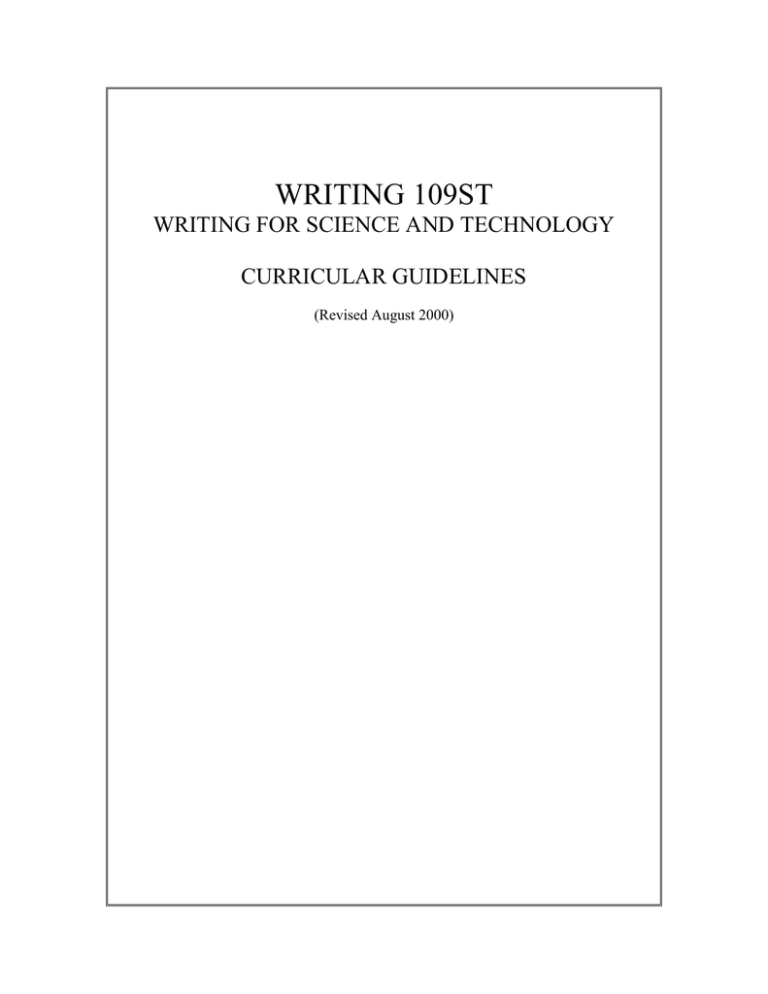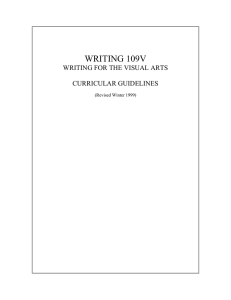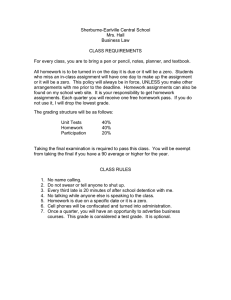WRITING 109ST WRITING FOR SCIENCE AND TECHNOLOGY CURRICULAR GUIDELINES
advertisement

WRITING 109ST WRITING FOR SCIENCE AND TECHNOLOGY CURRICULAR GUIDELINES (Revised August 2000) COURSE TITLE Writing 109ST: Writing for Science and Technology. PREREQUISITES Writing 2, 2LK, 2E, or equivalent; upper-division standing or consent of instructor. Not open for credit to students who have completed English 109A. CATALOG DESCRIPTION Analysis and practice of various forms of scientific and technical writing, both academic and professional, such as reports, proposals, journal articles, and abstracts. Attention to research methods, design of papers, development of graphics, technical style, and editing strategies. COURSE DESCRIPTION Writing 109ST is designed to increase students’ ability to communicate scientific and technical information in a variety of formats and for multiple purposes and audiences. Class activities may include lectures on form and style of technical documents; discussion of reading assignments; grammar reviews; exercises with graphics and document design; collaborative editing; oral presentations; electronic writing; and discussion of research methods. Students prepare a portfolio of documents that may include such genres as CV, recommendation report, proposal, progress report, journal analysis, and research review. A scheduled orientation with a specialist science librarian is required, and at least one collaborative project is recommended. Students who do not have competence in standard software applications such as MS Office programs can be directed to the orientations offered by Instructional Computing each quarter. Most students who take Writing 109ST are majors in the division of Mathematical, Physical, and Life Sciences, though a small number each quarter are Humanities or Social Science majors preparing for the Writing Program Minor in Professional Writing. The emphasis in Writing 109ST is on writing for professionals in the various scientific disciplines and in the related evolving technologies. As such, it is not the kind of “technical writing” that professional technical writers do (for the computer industry, for example), but writing that is an intrinsic part of “doing science.” The major objective in Writing 109ST is that students understand the forms and functions of various information products (including oral presentations) that are used to record and advance the work of science. Students are encouraged to relate the work they do in Writing 109ST to the information they are acquiring in the science courses that they take. Much of the subject matter for papers is drawn from these courses; often a synergy develops between the two learning experiences. COURSE REQUIREMENTS Reading and Writing Assignments Students are typically required to read a textbook about scientific communication and to locate and read a significant number of research articles on the subject of their choice, resulting in a formal literature review, research report, or proposal. The common written genres in Writing 109ST include memos, letters, electronic mail, proposals, progress reports, several kinds of reports, journal articles, instructions and procedures, documentation, and CV/resumes. Students present their term projects orally, and they learn to prepare slides using presentation software, and other graphic support for their presentations. Informal writing assignments include required e-mail interaction as well as in-class grammar tests and editing projects. Grading Instructors devise a scheme by which grades will be determined, considering formal and informal projects (oral and written) and they communicate that scheme to students in the beginning of the quarter. OUTCOMES After taking a Writing 109 course, students should be able to: Recognize and analyze discipline-specific formats and organizational strategies Understand specialized terminology of the discipline or field Understand how evidence is typically used in the field to support theories or arguments Access secondary source materials using a range of resources, including specialized professional journals and databases, websites, and popular literature Be aware of the differences between primary and secondary research Conduct a significant independent research project Cite and document sources in a manner appropriate for the field Produce a series of shorter texts that demonstrate typical content, formats, and stylistic conventions of the field Refine and develop a mature style of writing appropriate for the field Tailor writing to meet the requirements of lay, professional, or specialized audiences Translate complex writing into clear, concise language.



